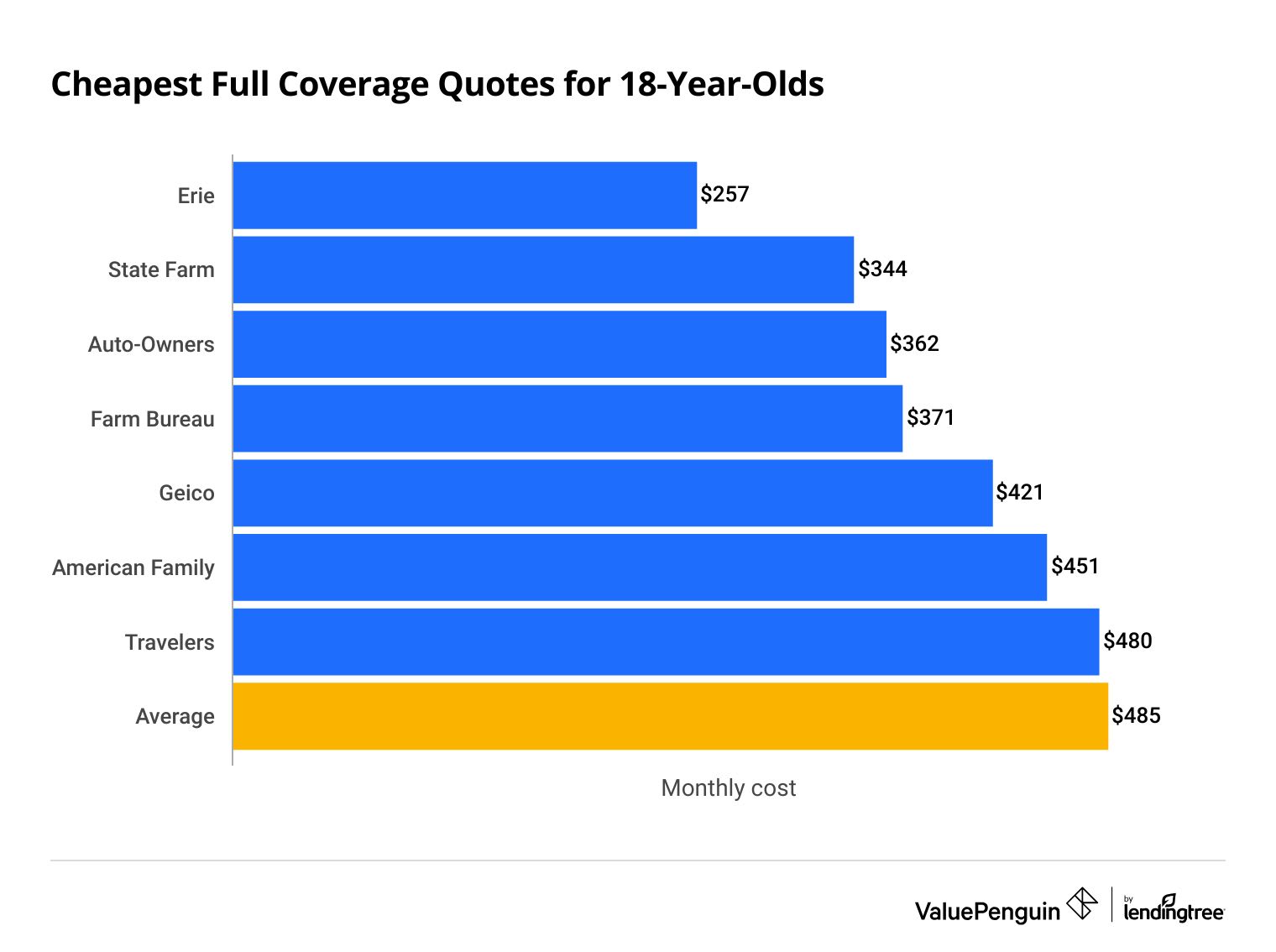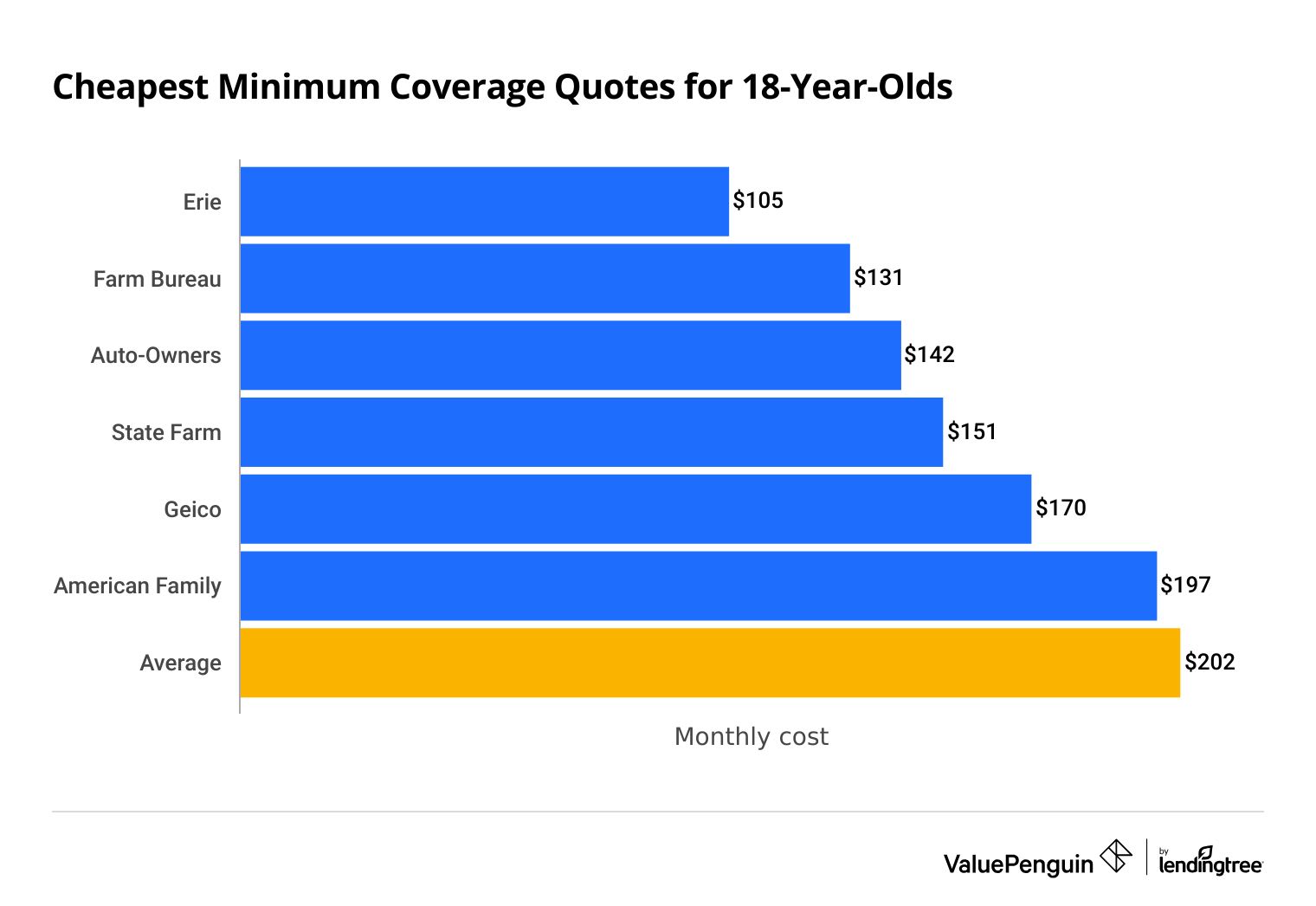Average Cost of Car Insurance for 18-Year-Olds
The average cost of full coverage car insurance for 18-year-olds is $485 per month. Minimum coverage costs an average of $202 per month.
Erie and State Farm have the cheapest car insurance for 18-year-olds. To find the cheapest rates for you, compare quotes from multiple companies.
How much is insurance for an 18-year-old?
Full coverage car insurance for an 18-year-old driver on their own policy costs an average of $485 per month.
The cheapest major car insurance company for 18-year-old drivers is State Farm.
A full coverage policy from State Farm costs around $344 per month.
Regional companies like Erie, Farm Bureau and Auto-Owners tend to offer very affordable rates for 18-year-olds. But they're not available in every state.
Find Cheap 18-year-old Auto Insurance Quotes
There's a difference of $522 per month between the cheapest company for full coverage, Erie, and the most expensive, Farmers. That's why you should always compare insurance quotes to find the best rates for you.
Cheap full coverage car insurance for 18-year-old drivers
How do car insurance rates for 18-year-olds compare to other ages?
An 18-year-old driver can expect to pay less for car insurance than younger, less experienced drivers.
However, drivers under the age of 25 tend to have high insurance rates. That's because they're more likely to make mistakes and cause accidents. As you get older and have more years of driving under your belt, your insurance rates should start to drop.
Do car insurance rates go down at age 18?
On average, 18-year-old drivers pay 20% less for car insurance than 17-year-olds. At 18 years old, you have more driving experience than newly licensed 16- and 17-year-olds do. Your rates reflect that.
New drivers are the exception to this rule. If you're a new driver at 18 years old, you will likely pay more than a driver who was licensed at age 16 and has two years of driving experience.
Average car insurance cost for 18-year-old male vs. female drivers
The average cost of car insurance for 18-year-old female drivers is 13% cheaper than that for 18-year-old male drivers. For 18-year-olds, women pay $490 per month for full coverage, while men pay $565.
Monthly full coverage car insurance rates by gender
Age | Male | Female |
|---|---|---|
| 18 | $565 | $490 |
| 19 | $444 | $382 |
| 20 | $383 | $331 |
The number of deaths related to car crashes for men ages 16 to 19 is three times as high as the rate for women in that age group, according to the Centers for Disease Control and Prevention (CDC). That makes male teens a much higher risk to insurance companies.
However, some states don't allow insurance companies to use gender to determine car insurance rates.
- California
- Hawaii
- Massachusetts
- Michigan (in certain cities)
- Montana
- North Carolina
- Pennsylvania
Men and women in these locations should pay the same price for auto insurance coverage, all else being equal.
Cheapest car insurance for 18-year-olds by state
The cheapest company nationally may not be the most affordable option in your state.
The cheapest major company, State Farm, is the least expensive option in 16 states.
However, Erie and Geico each have the best rates in seven states. And Farm Bureau is the most affordable company in six states.
Where you live also has a big effect on how much you pay for car insurance. Hawaii is the cheapest state for an 18-year-old to get car insurance. The average rate of $145 per month for full coverage is three times less than the national average. Rhode Island is the most expensive state, at $887 per month.
Full coverage car insurance quotes for 18-year-olds
State | State avg. | Cheapest rate | |
|---|---|---|---|
| Alabama | $502 | State Farm | $249 |
| Alaska | $369 | Umialik | $297 |
| Arizona | $684 | Geico | $372 |
| Arkansas | $496 | Farm Bureau | $217 |
| California | $370 | State Farm | $282 |
Can an 18-year-old get their own car insurance?
An 18-year-old can buy their own car insurance policy. However, you should share a policy with your parents if possible. It's usually much cheaper than having your own separate policy.
The average cost to add an 18-year-old to a parent's car insurance policy is $271 per month for full coverage. That's $214 less per month than the average cost of an 18-year-old getting their own car insurance.
Parents will typically see their rates go up when they add a teen driver to their policy. They can help offset the increased cost by asking for discounts. For example, parents might be able to get a multicar discount if their teen drives a separate car. Or they could get a good student discount if their teen has a 3.0 GPA.
How to get cheap insurance for 18-years-olds
Besides staying on your parents' policy, the best way to get cheap auto insurance quotes is to shop around. Prices can vary by thousands of dollars per year. So it's helpful to compare car insurance quotes from multiple insurance companies.
There are a number of other ways 18-year-olds can get cheap car insurance, including:
Frequently asked questions
How much is insurance for an 18-year-old per month?
An 18-year-old can expect to pay an average of $485 per month for full coverage car insurance. Minimum coverage costs around $202 per month. However, rates vary significantly based on where you live and the insurance company you choose.
Can an 18-year-old get car insurance on their own?
Yes, 18-year-olds can get car insurance policies on their own. However, you could pay much less if you share a policy with your parents.
Is insurance cheaper when you turn 18?
An 18-year-old driver can expect to pay around 20% less for car insurance than a 17-year-old. Rates are usually cheaper for 18-year-olds because they have more experience behind the wheel than younger drivers. However, a newly licensed 18-year-old will pay more for car insurance than someone who has been driving since they turned 16.
Is it cheaper to be on your parents' car insurance?
Yes, it is cheaper for teen drivers to share car insurance with their parents. On average, 18-year-old drivers can save $214 per month on full coverage insurance by having a joint family policy.
Who has the cheapest car insurance for 18-year-olds?
Erie has the cheapest full coverage rate for 18-year-old drivers, at $257 per month. However, it's only available in 12 states and Washington, D.C. State Farm has the best widely available rate, at $344 per month for full coverage.
However, the cheapest company for you may be different depending on where you live.
Methodology
To find the average cost of car insurance for an 18-year-old, ValuePenguin collected quotes for ZIP codes across all 50 states in the U.S. Rates are for an 18-year-old single man with a clean driving record and good credit who owns a 2015 Honda Civic.
Full coverage quotes include higher liability limits than each state requires, along with comprehensive and collision coverage.
- Bodily injury liability: $50,000 per person and $100,000 per accident
- Property damage liability: $25,000 per accident
- Uninsured and underinsured motorist bodily injury: $50,000 per person and $100,000 per accident
- Comprehensive and collision: $500 deductible
- Personal injury protection (PIP): Minimum, when required by state
National averages include insurance rate data from Quadrant Information Services. The rates we collected were publicly sourced from insurance company filings and should only be used for comparative purposes. Your own quotes may differ from our averages.
To determine the rates for each age group, we collected quotes for thousands of ZIP codes across 10 of the most populous states in the country.
To find the average rate by gender, we compared quotes for full coverage car insurance for ZIP codes across Georgia.
The average cost of adding an 18-year-old to a parent’s policy is based on full coverage quotes from thousands of ZIP codes across Illinois, Pennsylvania and Georgia. Quotes are for a 50-year-old with an 18-year-old on their policy.
Sources
Editorial Note: The content of this article is based on the author's opinions and recommendations alone. It has not been previewed, commissioned or otherwise endorsed by any of our network partners.


